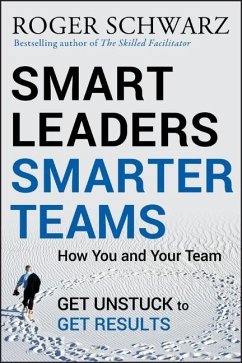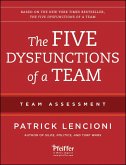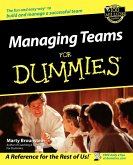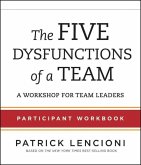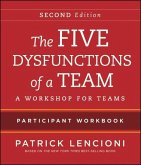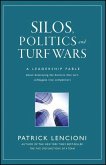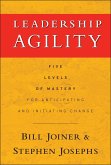- Gebundenes Buch
- Merkliste
- Auf die Merkliste
- Bewerten Bewerten
- Teilen
- Produkt teilen
- Produkterinnerung
- Produkterinnerung
A proven approach for helping leaders and teams work together to achieve better decisions, greater commitment, and stronger results More than ever, effective leadership requires us to work as a team, but many leaders struggle to get the results they need. When stakes are high, you can t get great results by just changing what you do. You also need to change how you think. Organizational psychologist and leadership consultant Roger Schwarz applies his 30+ years of experience working with leadership teams to reveal how leaders can drastically improve results by changing their individual and team…mehr
Andere Kunden interessierten sich auch für
![The Five Dysfunctions of a Team The Five Dysfunctions of a Team]() Patrick M. LencioniThe Five Dysfunctions of a Team21,99 €
Patrick M. LencioniThe Five Dysfunctions of a Team21,99 €![Managing Teams for Dummies Managing Teams for Dummies]() Marty BrounsteinManaging Teams for Dummies25,99 €
Marty BrounsteinManaging Teams for Dummies25,99 €![The Five Dysfunctions of a Team The Five Dysfunctions of a Team]() Patrick M. LencioniThe Five Dysfunctions of a Team68,99 €
Patrick M. LencioniThe Five Dysfunctions of a Team68,99 €![The Five Dysfunctions of a Team The Five Dysfunctions of a Team]() Patrick M. LencioniThe Five Dysfunctions of a Team69,99 €
Patrick M. LencioniThe Five Dysfunctions of a Team69,99 €![Silos, Politics and Turf Wars Silos, Politics and Turf Wars]() Patrick M. LencioniSilos, Politics and Turf Wars23,99 €
Patrick M. LencioniSilos, Politics and Turf Wars23,99 €![Leadership Agility Leadership Agility]() William B. JoinerLeadership Agility31,99 €
William B. JoinerLeadership Agility31,99 €![Teaming Teaming]() Amy C. EdmondsonTeaming33,99 €
Amy C. EdmondsonTeaming33,99 €-
-
-
A proven approach for helping leaders and teams work together to achieve better decisions, greater commitment, and stronger results
More than ever, effective leadership requires us to work as a team, but many leaders struggle to get the results they need. When stakes are high, you can t get great results by just changing what you do. You also need to change how you think. Organizational psychologist and leadership consultant Roger Schwarz applies his 30+ years of experience working with leadership teams to reveal how leaders can drastically improve results by changing their individual and team mindset.
Provides practical guidance to help teams increase decision quality, decrease implementation time, foster innovation, get commitment, reduce costs and increase trust
Outlines 5 core values leadership teams can adopt to exponentially improve results
Author of The Skilled Facilitator and The Skilled Facilitator Fieldbook
Get the results you and your team need. Start by applying the practical wisdom of Smart Leaders, Smarter Teams.
Hinweis: Dieser Artikel kann nur an eine deutsche Lieferadresse ausgeliefert werden.
More than ever, effective leadership requires us to work as a team, but many leaders struggle to get the results they need. When stakes are high, you can t get great results by just changing what you do. You also need to change how you think. Organizational psychologist and leadership consultant Roger Schwarz applies his 30+ years of experience working with leadership teams to reveal how leaders can drastically improve results by changing their individual and team mindset.
Provides practical guidance to help teams increase decision quality, decrease implementation time, foster innovation, get commitment, reduce costs and increase trust
Outlines 5 core values leadership teams can adopt to exponentially improve results
Author of The Skilled Facilitator and The Skilled Facilitator Fieldbook
Get the results you and your team need. Start by applying the practical wisdom of Smart Leaders, Smarter Teams.
Hinweis: Dieser Artikel kann nur an eine deutsche Lieferadresse ausgeliefert werden.
Produktdetails
- Produktdetails
- Verlag: Wiley & Sons
- 1. Auflage
- Seitenzahl: 272
- Erscheinungstermin: 18. März 2013
- Englisch
- Abmessung: 235mm x 161mm x 27mm
- Gewicht: 461g
- ISBN-13: 9780787988739
- ISBN-10: 0787988731
- Artikelnr.: 36622454
- Herstellerkennzeichnung
- Libri GmbH
- Europaallee 1
- 36244 Bad Hersfeld
- gpsr@libri.de
- Verlag: Wiley & Sons
- 1. Auflage
- Seitenzahl: 272
- Erscheinungstermin: 18. März 2013
- Englisch
- Abmessung: 235mm x 161mm x 27mm
- Gewicht: 461g
- ISBN-13: 9780787988739
- ISBN-10: 0787988731
- Artikelnr.: 36622454
- Herstellerkennzeichnung
- Libri GmbH
- Europaallee 1
- 36244 Bad Hersfeld
- gpsr@libri.de
ROGER SCHWARZ has been a recognized thought leader in the realm of team leadership for three decades. An organizational psychologist and president and CEO of Roger Schwarz Associates, he is a sought-after advisor to global companies, federal government agencies, and international nonprofit organizations. Clients include Hewlett-Packard, the American Red Cross, the World Bank, TransCanada, Chevron, and the U.S. Department of the Interior. He is author of the seminal work The Skilled Facilitator and coauthor of The Skilled Facilitator Fieldbook. He holds a Ph.D. in organizational psychology from the University of Michigan, and a master of education degree from Harvard University. Schwarz lives in Chapel Hill with his wife. They have two children. www.schwarzassociates.com
Preface xi
Who this book is for, what it is about, and why I wrote it.
1 How Well Does Your Team Really Work? 1
Why does a group of smart leaders so often create a less-than-smart team?
This chapter describes how the mindset leaders use can get them and their
team stuck. It explains why adopting a mutual learning set of values and
assumptions gets you and your team unstuck so that you get more done and
achieve your goals.
2 How You and Your Team Get Stuck: The Unilateral Control Approach 25
When you and your team try to achieve your goals by unilaterally
controlling the situation, you get the very results you've been trying to
avoid. This chapter enables you to compare your own mindset and behaviors
to those of a unilaterally controlling leader, so you can understand the
mindset from which you are operating.
3 Getting Unstuck to Get Results: The Mutual Learning Approach 49
When you shift to a mutual learning mindset, you and your team operate from
a more productive set of values and assumptions. These include being
transparent, curious, accountable, and compassionate, and creating informed
choice. This chapter demonstrates how that mindset generates common
understanding that transforms decision making to produce better team
performance, stronger team working relationships, and work that is
satisfying and motivating.
4 Getting the Puzzle Pieces on the Table: Mutual Learning Behaviors 1-4 87
How you think is how you lead. This chapter provides detailed guidance on
how to put the mutual learning mindset into action through four mutual
learning behaviors: state views and ask genuine questions, share all
relevant information, use specific examples and agree on what important
words mean, and explain your reasoning and intent. See how these behaviors
lead you and your team to higher quality decisions, shorter implementation
time, and greater commitment and trust.
5 Putting the Puzzle Together: Mutual Learning Behaviors 5-8 109
Continuing from Chapter Four, this chapter provides detailed guidance on
how to put the mutual learning mindset into action through four more mutual
learning behaviors: focus on interests not positions, test assumptions and
inferences, jointly design next steps, and discuss undiscussable issues.
6 Designing for Mutual Learning 143
How you design-or redesign-your team shapes whether your team gets the
results you want or the results you're trying to avoid. See how to enhance
your team structures, processes, and context to get more effective decision
making, less unproductive conflict, and greater commitment.
7 Dealing With Common Team Challenges 177
Most teams face challenges that are easily addressed by using a mutual
learning approach. This chapter describes how to apply the mutual learning
mindset and behaviors to deal with these challenges, including keeping team
meetings on track, speaking with one voice as a team, preventing end runs,
and giving and receiving feedback.
8 Becoming a Smarter Leader 199
Have you decided to become a smarter leader through mutual learning? This
chapter helps you take stock of what you want to achieve, develop an action
plan for what you want to change and why, and prepare to talk with your
team about your changes. Together these steps will help you engage your
team to support your leadership change.
9 Becoming a Smarter Team 215
Your team has greater power to get better results when you and the team
decide to change together. The stakes are higher, but so are the rewards.
This chapter provides specific steps to help you and your team take stock
of what the team wants to achieve, develop a team action plan for change,
and plan for team conversations to begin the change. Together, these steps
will help you create a team whose results exceed the sum of its parts.
Notes 233
Acknowledgments 241
About the Author 245
Index 247
Who this book is for, what it is about, and why I wrote it.
1 How Well Does Your Team Really Work? 1
Why does a group of smart leaders so often create a less-than-smart team?
This chapter describes how the mindset leaders use can get them and their
team stuck. It explains why adopting a mutual learning set of values and
assumptions gets you and your team unstuck so that you get more done and
achieve your goals.
2 How You and Your Team Get Stuck: The Unilateral Control Approach 25
When you and your team try to achieve your goals by unilaterally
controlling the situation, you get the very results you've been trying to
avoid. This chapter enables you to compare your own mindset and behaviors
to those of a unilaterally controlling leader, so you can understand the
mindset from which you are operating.
3 Getting Unstuck to Get Results: The Mutual Learning Approach 49
When you shift to a mutual learning mindset, you and your team operate from
a more productive set of values and assumptions. These include being
transparent, curious, accountable, and compassionate, and creating informed
choice. This chapter demonstrates how that mindset generates common
understanding that transforms decision making to produce better team
performance, stronger team working relationships, and work that is
satisfying and motivating.
4 Getting the Puzzle Pieces on the Table: Mutual Learning Behaviors 1-4 87
How you think is how you lead. This chapter provides detailed guidance on
how to put the mutual learning mindset into action through four mutual
learning behaviors: state views and ask genuine questions, share all
relevant information, use specific examples and agree on what important
words mean, and explain your reasoning and intent. See how these behaviors
lead you and your team to higher quality decisions, shorter implementation
time, and greater commitment and trust.
5 Putting the Puzzle Together: Mutual Learning Behaviors 5-8 109
Continuing from Chapter Four, this chapter provides detailed guidance on
how to put the mutual learning mindset into action through four more mutual
learning behaviors: focus on interests not positions, test assumptions and
inferences, jointly design next steps, and discuss undiscussable issues.
6 Designing for Mutual Learning 143
How you design-or redesign-your team shapes whether your team gets the
results you want or the results you're trying to avoid. See how to enhance
your team structures, processes, and context to get more effective decision
making, less unproductive conflict, and greater commitment.
7 Dealing With Common Team Challenges 177
Most teams face challenges that are easily addressed by using a mutual
learning approach. This chapter describes how to apply the mutual learning
mindset and behaviors to deal with these challenges, including keeping team
meetings on track, speaking with one voice as a team, preventing end runs,
and giving and receiving feedback.
8 Becoming a Smarter Leader 199
Have you decided to become a smarter leader through mutual learning? This
chapter helps you take stock of what you want to achieve, develop an action
plan for what you want to change and why, and prepare to talk with your
team about your changes. Together these steps will help you engage your
team to support your leadership change.
9 Becoming a Smarter Team 215
Your team has greater power to get better results when you and the team
decide to change together. The stakes are higher, but so are the rewards.
This chapter provides specific steps to help you and your team take stock
of what the team wants to achieve, develop a team action plan for change,
and plan for team conversations to begin the change. Together, these steps
will help you create a team whose results exceed the sum of its parts.
Notes 233
Acknowledgments 241
About the Author 245
Index 247
Preface xi
Who this book is for, what it is about, and why I wrote it.
1 How Well Does Your Team Really Work? 1
Why does a group of smart leaders so often create a less-than-smart team?
This chapter describes how the mindset leaders use can get them and their
team stuck. It explains why adopting a mutual learning set of values and
assumptions gets you and your team unstuck so that you get more done and
achieve your goals.
2 How You and Your Team Get Stuck: The Unilateral Control Approach 25
When you and your team try to achieve your goals by unilaterally
controlling the situation, you get the very results you've been trying to
avoid. This chapter enables you to compare your own mindset and behaviors
to those of a unilaterally controlling leader, so you can understand the
mindset from which you are operating.
3 Getting Unstuck to Get Results: The Mutual Learning Approach 49
When you shift to a mutual learning mindset, you and your team operate from
a more productive set of values and assumptions. These include being
transparent, curious, accountable, and compassionate, and creating informed
choice. This chapter demonstrates how that mindset generates common
understanding that transforms decision making to produce better team
performance, stronger team working relationships, and work that is
satisfying and motivating.
4 Getting the Puzzle Pieces on the Table: Mutual Learning Behaviors 1-4 87
How you think is how you lead. This chapter provides detailed guidance on
how to put the mutual learning mindset into action through four mutual
learning behaviors: state views and ask genuine questions, share all
relevant information, use specific examples and agree on what important
words mean, and explain your reasoning and intent. See how these behaviors
lead you and your team to higher quality decisions, shorter implementation
time, and greater commitment and trust.
5 Putting the Puzzle Together: Mutual Learning Behaviors 5-8 109
Continuing from Chapter Four, this chapter provides detailed guidance on
how to put the mutual learning mindset into action through four more mutual
learning behaviors: focus on interests not positions, test assumptions and
inferences, jointly design next steps, and discuss undiscussable issues.
6 Designing for Mutual Learning 143
How you design-or redesign-your team shapes whether your team gets the
results you want or the results you're trying to avoid. See how to enhance
your team structures, processes, and context to get more effective decision
making, less unproductive conflict, and greater commitment.
7 Dealing With Common Team Challenges 177
Most teams face challenges that are easily addressed by using a mutual
learning approach. This chapter describes how to apply the mutual learning
mindset and behaviors to deal with these challenges, including keeping team
meetings on track, speaking with one voice as a team, preventing end runs,
and giving and receiving feedback.
8 Becoming a Smarter Leader 199
Have you decided to become a smarter leader through mutual learning? This
chapter helps you take stock of what you want to achieve, develop an action
plan for what you want to change and why, and prepare to talk with your
team about your changes. Together these steps will help you engage your
team to support your leadership change.
9 Becoming a Smarter Team 215
Your team has greater power to get better results when you and the team
decide to change together. The stakes are higher, but so are the rewards.
This chapter provides specific steps to help you and your team take stock
of what the team wants to achieve, develop a team action plan for change,
and plan for team conversations to begin the change. Together, these steps
will help you create a team whose results exceed the sum of its parts.
Notes 233
Acknowledgments 241
About the Author 245
Index 247
Who this book is for, what it is about, and why I wrote it.
1 How Well Does Your Team Really Work? 1
Why does a group of smart leaders so often create a less-than-smart team?
This chapter describes how the mindset leaders use can get them and their
team stuck. It explains why adopting a mutual learning set of values and
assumptions gets you and your team unstuck so that you get more done and
achieve your goals.
2 How You and Your Team Get Stuck: The Unilateral Control Approach 25
When you and your team try to achieve your goals by unilaterally
controlling the situation, you get the very results you've been trying to
avoid. This chapter enables you to compare your own mindset and behaviors
to those of a unilaterally controlling leader, so you can understand the
mindset from which you are operating.
3 Getting Unstuck to Get Results: The Mutual Learning Approach 49
When you shift to a mutual learning mindset, you and your team operate from
a more productive set of values and assumptions. These include being
transparent, curious, accountable, and compassionate, and creating informed
choice. This chapter demonstrates how that mindset generates common
understanding that transforms decision making to produce better team
performance, stronger team working relationships, and work that is
satisfying and motivating.
4 Getting the Puzzle Pieces on the Table: Mutual Learning Behaviors 1-4 87
How you think is how you lead. This chapter provides detailed guidance on
how to put the mutual learning mindset into action through four mutual
learning behaviors: state views and ask genuine questions, share all
relevant information, use specific examples and agree on what important
words mean, and explain your reasoning and intent. See how these behaviors
lead you and your team to higher quality decisions, shorter implementation
time, and greater commitment and trust.
5 Putting the Puzzle Together: Mutual Learning Behaviors 5-8 109
Continuing from Chapter Four, this chapter provides detailed guidance on
how to put the mutual learning mindset into action through four more mutual
learning behaviors: focus on interests not positions, test assumptions and
inferences, jointly design next steps, and discuss undiscussable issues.
6 Designing for Mutual Learning 143
How you design-or redesign-your team shapes whether your team gets the
results you want or the results you're trying to avoid. See how to enhance
your team structures, processes, and context to get more effective decision
making, less unproductive conflict, and greater commitment.
7 Dealing With Common Team Challenges 177
Most teams face challenges that are easily addressed by using a mutual
learning approach. This chapter describes how to apply the mutual learning
mindset and behaviors to deal with these challenges, including keeping team
meetings on track, speaking with one voice as a team, preventing end runs,
and giving and receiving feedback.
8 Becoming a Smarter Leader 199
Have you decided to become a smarter leader through mutual learning? This
chapter helps you take stock of what you want to achieve, develop an action
plan for what you want to change and why, and prepare to talk with your
team about your changes. Together these steps will help you engage your
team to support your leadership change.
9 Becoming a Smarter Team 215
Your team has greater power to get better results when you and the team
decide to change together. The stakes are higher, but so are the rewards.
This chapter provides specific steps to help you and your team take stock
of what the team wants to achieve, develop a team action plan for change,
and plan for team conversations to begin the change. Together, these steps
will help you create a team whose results exceed the sum of its parts.
Notes 233
Acknowledgments 241
About the Author 245
Index 247

